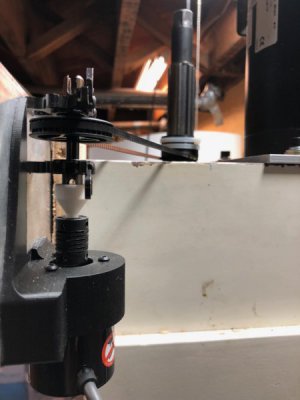Some thoughts from somebody who is not remotely competent to fine-tune a PID control...
The Acorn's encoder will need to be enabled for rigid tapping. Otherwise it can't synchronize the Z-axis. Don't forget to enable it and see if starts fighting the GS3 when you do some 'air' tapping. If the Acorn doesn't have a spindle PID settings page or screen, then it's probably not doing anything but sending out a static 0-10V signal to the GS3 (for a given programmed RPM) and it shouldn't be fighting the VFD.
Once you've got the initial tune sorted out, I suggest taking a fairly heavy cut with a fly cutter on a chunk of scrap. The intermittent load should help you see if the GS3 is tuned appropriately or if it's hunting for an appropriate speed as the tool does the usual thump-thump-thump deal.
Then do a heavy(ish) profiling cut with an end mill to generate a constant load and see if that's good to go or if you need to fiddle with the PID settings some more.
An interesting feature (bug?) I found in my controller is that if I program a rigid tapping cycle but leave the S word (spindle speed) out, the controller shifts to synchronized Z-axis mode and I can turn the spindle by hand and it will advance by the programmed thread pitch distance. Put an indicator on the head and rotate the spindle a couple of times and it's cake to check if the programmed pitch matches your tap TPI.
Once you've got the VFD sorted out - and you will - you might see if the Acorn has a similar feature. It's pretty handy.
-S
The Acorn's encoder will need to be enabled for rigid tapping. Otherwise it can't synchronize the Z-axis. Don't forget to enable it and see if starts fighting the GS3 when you do some 'air' tapping. If the Acorn doesn't have a spindle PID settings page or screen, then it's probably not doing anything but sending out a static 0-10V signal to the GS3 (for a given programmed RPM) and it shouldn't be fighting the VFD.
Once you've got the initial tune sorted out, I suggest taking a fairly heavy cut with a fly cutter on a chunk of scrap. The intermittent load should help you see if the GS3 is tuned appropriately or if it's hunting for an appropriate speed as the tool does the usual thump-thump-thump deal.
Then do a heavy(ish) profiling cut with an end mill to generate a constant load and see if that's good to go or if you need to fiddle with the PID settings some more.
An interesting feature (bug?) I found in my controller is that if I program a rigid tapping cycle but leave the S word (spindle speed) out, the controller shifts to synchronized Z-axis mode and I can turn the spindle by hand and it will advance by the programmed thread pitch distance. Put an indicator on the head and rotate the spindle a couple of times and it's cake to check if the programmed pitch matches your tap TPI.
Once you've got the VFD sorted out - and you will - you might see if the Acorn has a similar feature. It's pretty handy.
-S


